-
1 of 253523 objects
Cuirassier armour of Henry, future Prince of Wales about 1607
Iron, blueing, gold, copper alloy (brass), leather, textiles. | RCIN 72832
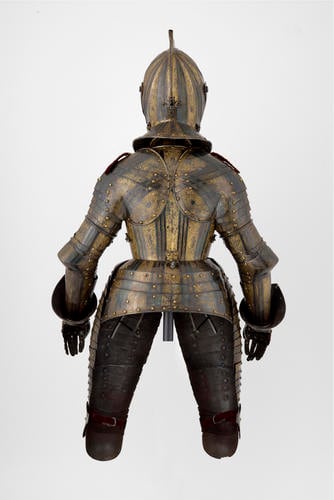
France
Cuirassier armour of Henry, future Prince of Wales about 1607
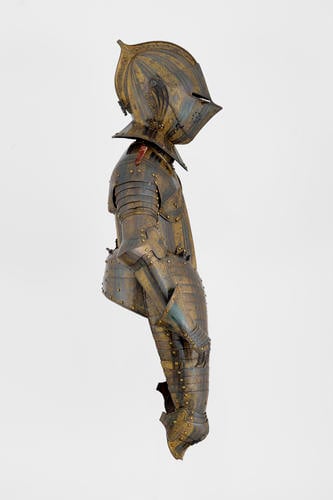
France
Cuirassier armour of Henry, future Prince of Wales about 1607
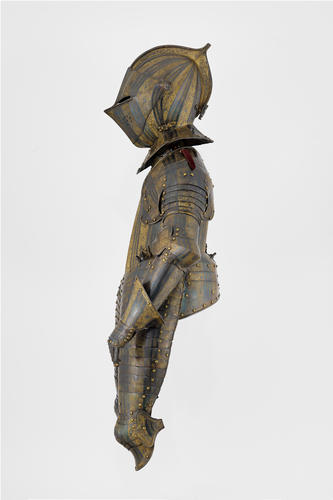
France
Cuirassier armour of Henry, future Prince of Wales about 1607
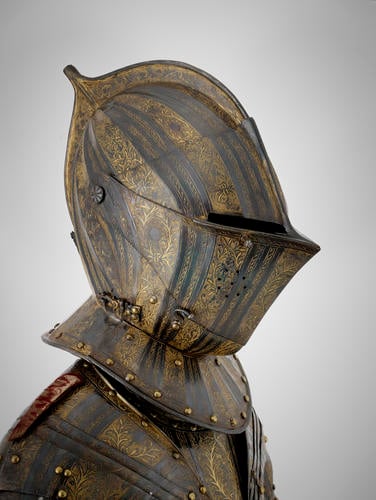
France
Cuirassier armour of Henry, future Prince of Wales about 1607
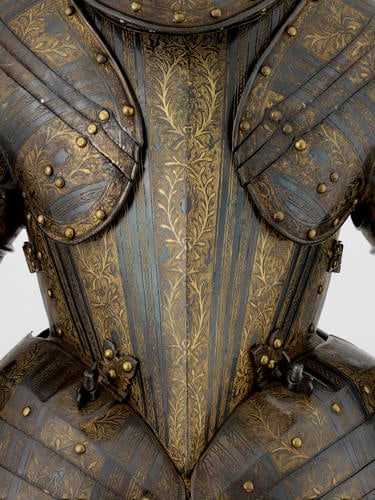
France
Cuirassier armour of Henry, future Prince of Wales about 1607

France
Cuirassier armour of Henry, future Prince of Wales about 1607
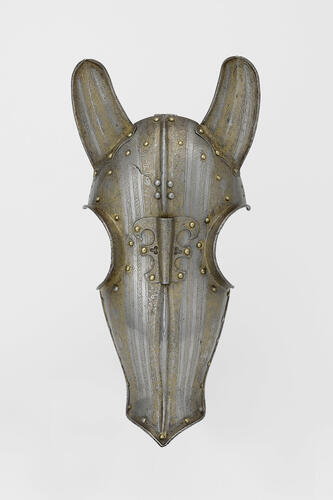
France
Master: Cuirassier armour of Henry, future Prince of Wales about 1607
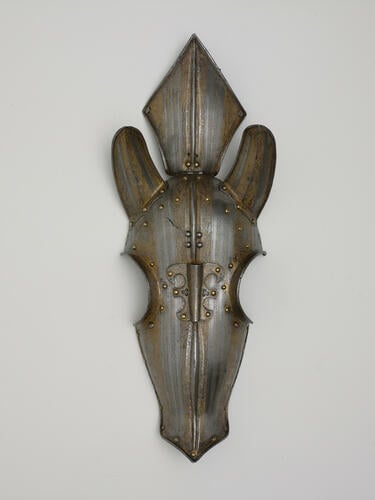
France
Master: Cuirassier armour of Henry, future Prince of Wales about 1607

France
Cuirassier armour of Henry, future Prince of Wales about 1607










-
Cuirassier armour of Henry, future Prince of Wales, consisting of a close helmet for the field, a gorget, a cuirass, a pair of tassets with detachable extensions to the knees, a culet, a pair of symmetrical pauldrons and vambraces, a pair of gauntlets and a full shaffron.
The whole surface of the armour is decorated with bands of etched ornament. The bands are etched alternately in line with gold in the lines on a plain ground and, in relief, against a gilt ground closely covered with scribbled dots and semée of drops of fire. In the former, the decoration consists only of two parallel bands of stylized roping formed by raked Zs, each enclosed between two lines, and enclosed overall by a single line near each side. In the latter, the decoration consists of entwined laurel or olive foliage tied with a fillet in base, alternating with ovals edged with palm fronds crossed at each end and tied in base in the same way, framing a hand looking-glass apparently wreathed in fire or feathers. Some of the ovals frame small classical figures. The ground within the etched features is plain and fire-gilt. The turned free edges of the armour are followed throughout by a narrow band etched in line with gold in the lines, and consisting of a running scroll of foliage on a diagonally hatched ground.
The armour appears in two miniatures of Henry, future Prince of Wales (1594-1612) by Nicholas Hilliard (1547-1619), one of which is dated 1607. Both show the armour white and gold without any traces of colour of any sort. However, with the exception of those of the shaffron, all the surfaces of the armour are now gilt and a very dark blue. The blueing was probably applied in 1902, at the same time as that on the future Prince's armours for the tilt (RCIN 72830) and for the field, tourney, tilt and barriers (RCIN 72831). The shaffron, which did not arrive at Windsor until 1914, retains its original white-and-gold colour scheme.
Tests undertaken on the rear gorgetplate of the helmet show it to have a microhardness in the range 146–191 VPH (average 166 VPH). It is largely composed of iron with numerous irregular slag-inclusions. The iron, however, is accompanied by an irregular narrow band of mixed iron and a carburised iron (pearlite) with a carbon content of about 0.1%. The boundary between the two is marked by a row of slag-inclusions. This seems to be the relic of a folding operation, most likely carried out when the original heterogeneous ‘bloom’ produced in the furnace was turned into a plate, or possibly where several fragments of metal have been forged together. The upper cannon of the right vambrace is similarly constructed but the carbon content of its mixed band is about 0.2–.3%. It is estimated to have a microhardness in the range 150–80 VPH.
Text adapted from Norman, A.V.B, & Eaves, I. 2016. Arms and Armour in the Collection of Her Majesty The Queen: European Armour, London.
Metallurgy by Williams, A, & Metcalf, S. 2016. Summary of the metallurgy of European Armour in the Royal Collection. London. Appendix II of Norman & Eaves
Measurements: Helmet: height 33.0 cm, width at gorget-plates 21.6 cm, depth, 35.9 cm; Gorget: height 16.5 cm, internal diameter of neck 10.5 cm; Breastplate: height 38.6 cm, width beneath arm-openings 24.9 cm, width at waist 22.3 cm; Backplate: height 33.4 cm; Right Tasset: height without extension 35.4 cm, height with extension 61.0 cm, width 23.2 cm; Left Tasset: height without extension 33.4 cm, height with extension 61.0 cm, width 24.2 cm; Right Tasset-Extension: length 29.2 cm; Left Tasset-Extension: length 31.1 cm; Culet: height 18.8 cm, width 36.1 cm; Right Pauldron and Vambrace: length 55.6 cm, width of pauldron 21.6 cm; Left Pauldron and Vambrace: length 55.8 cm, width of pauldron 21.6 cm; Right Gauntlet:: length 25.1 cm; Left Gauntlet: 25.1 cm; Shaffron: length 51.1 cm, width above eyes: 23.4 cm.
Weights: Helmet: 0.652 kg; Gorget: 0.652 kg; Breastplate: 1.106 kg; Backplate: 1.035 kg; Right Tasset: 0.964 kg; Left Tasset: 0.907kg; Right Tasset-Extension: 0.709 kg; Left Tasset-Extension: 0.737 kg; Culet: 0.738 kg; Right Pauldron and Vambrace: 1.729 kg; Left Pauldron and Vambrace: 1.673 kg; Right Gauntlet: 0.255 kg; Left Gauntlet: 0.255 kg; Shaffron: 1.219 kg.
Provenance
The armour was given to Prince Henry by Claude de Lorraine, Prince de Joinville (later Duke of Chevreuse (1578–1657). Joinville, who was the son of Henri I, 3rd duc de Guise (1550–88), had come to England in May 1607. The Prince subsequently wrote to him in February 1608: ‘I perceive, my cousin, that during your stay in England, you discovered my humour; since you have sent me a present of the two things, which I most delight in, arms and horses.' This suggests that the armour was sent as a result of the visit, rather than being presented during it.
It may be that the Prince had admired one of Joinville's armours during his stay. Joinville had an armour 'whole gilt, engraved and enamelled with laurel branches, palms and trophies with mirrors surrounded by panels', commissioned from Guillaume Huguet in March 1607. This decoration, particularly its mirrors, is remarkably similar to that of the armour subsequently given to Prince Henry. It therefore seems possible that this design was chosen for the Prince's armour since he had seen and liked Huguet's work.
The armour first appears in the 1629 Remain in ‘the greate Chamber late Mr Pickeringes’ at Greenwich: ‘One small feild Armor guilte graven and enamelled given by Prince John Voile to Prince Henry’. In the 1631 Remain it is described as a field armour and is said to be ‘wanting the 2 gauntletts'.
It is included as no. 1 in the first group recorded in the manuscript ‘An Account of the Armour and Arms in the Guard Chamber at Windsor Castle’, prepared by the Board of Ordnance at the Tower of London on 29 July 1831 (Appendix IV), where it was recorded as ‘St George’. -
Creator(s)
(nationality)Acquirer(s)
-
Medium and techniques
Iron, blueing, gold, copper alloy (brass), leather, textiles.
Category
Object type(s)
Other number(s)